Containers and Pots
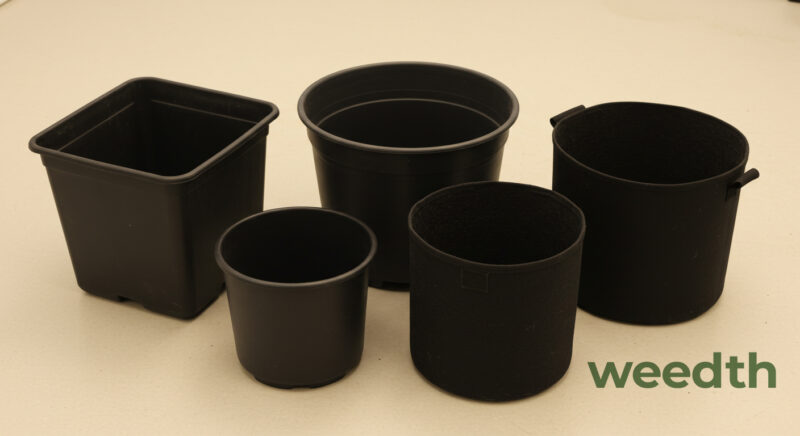
Growing cannabis in pots is a popular method among both indoor and outdoor growers due to its versatility and manageability. Potted cannabis benefits from the ability to easily control the soil environment and the flexibility to adjust plant positioning based on sunlight exposure and protective needs against the elements.
Pot Growing
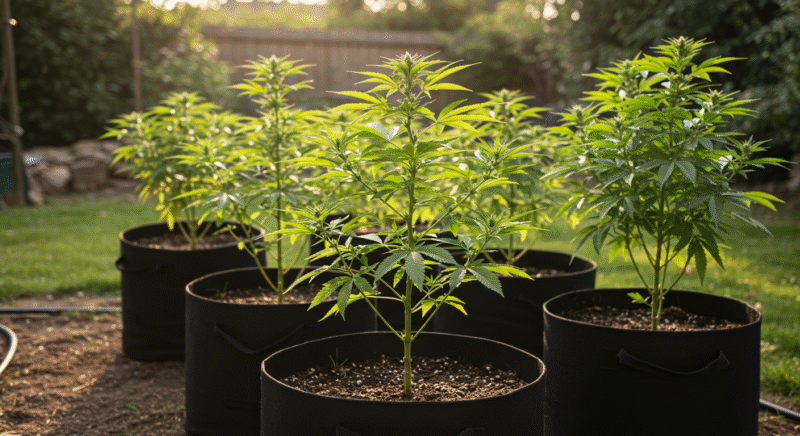
Using pots for cannabis cultivation involves placing the plants in containers that can vary widely in material, size, and design. You can use pots filled with soil or soilless growing media. This method is particularly favored when space is limited, such as in indoor grow rooms or on balconies and patios where direct planting in the ground isn’t feasible. Containers also offer an ideal solution in regions where the native soil is unsuitable for cannabis due to poor quality, contamination, or other environmental concerns. They also provide the flexibility to move plants around, which can be crucial for managing light exposure and protecting plants from adverse weather conditions.
Growers prefer pots because they can greatly control the growing medium. Potted cannabis can be grown in soil blends combined to meet the plant’s nutrient and pH preferences, unlike planting directly in the garden soil. This level of control helps prevent issues related to nutrient imbalances or soil-borne diseases, which are common in open garden settings.

Pots allow your plants to be moved to continually optimize their growing conditions. Whether adjusting for maximum sunlight exposure during the growth phases or protecting plants from harsh weather conditions such as frost or excessive rain, pots portability provides a strategic advantage. This mobility is particularly beneficial in climates that experience wide variations in weather, allowing growers to mitigate environmental stressors that could impact plant development and yield.
Pros of Container Growing
Mobility: One of the standout benefits of container growing is the mobility it affords. Containers allow growers to easily move their cannabis plants to optimize sunlight exposure throughout the day or quickly shelter them from adverse weather conditions. This flexibility is particularly valuable in regions with unpredictable weather, enabling growers to protect plants from too much direct sunlight, heavy rains, or sudden temperature drops.
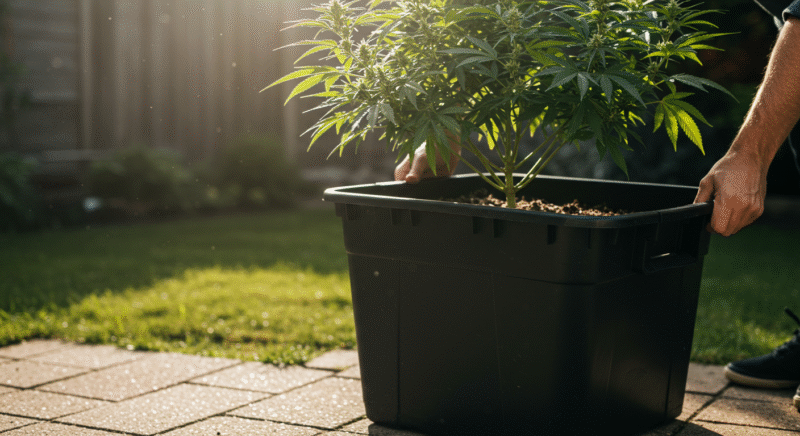
Controlled Environment: Containers provide an exceptional level of control over the growing environment, especially concerning the soil. Growers can tailor the soil mixture to the specific needs of the cannabis strain being grown, adjusting pH, nutrient levels, and soil composition. This precise control helps ensure optimal conditions for plant health and vigor, potentially leading to better yields and quality.
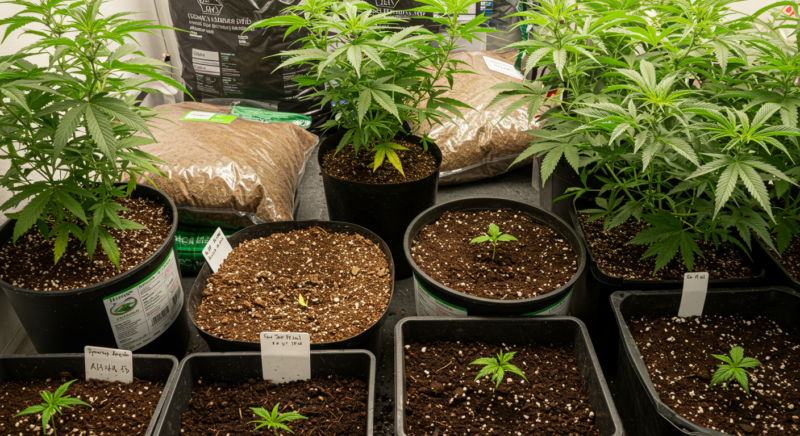
Pest Management: Growing in containers can significantly reduce the risk of soil-borne pests and diseases. Since the soil in containers can be chosen and managed separately, it is less likely to contain the pathogens and pests found in natural garden soil. This isolation helps prevent many common issues found in traditional ground planting, making pest management more straightforward.

Cons of Container Growing
Limited Root Space: The finite space within a container can restrict root development, which in turn can limit the overall growth and productivity of the plant. Restricted root growth can prevent the plant from reaching its full potential, affecting both the size and the yield of the cannabis. Selecting the appropriate container size is crucial to give cannabis plants enough room to expand their root systems adequately.
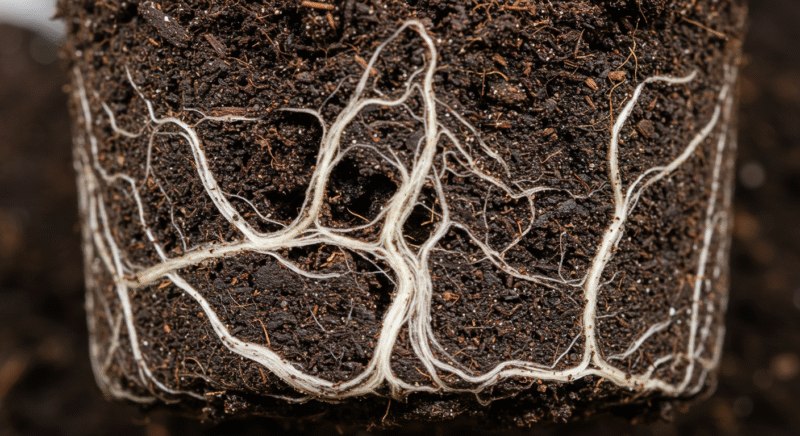
Frequent Watering: Soil in containers tends to dry out more quickly than soil in the ground. This faster rate of drying requires more frequent watering to maintain optimal soil moisture levels. For growers, this means a higher level of vigilance and more labor to ensure plants are adequately watered, particularly in hot or windy weather conditions.
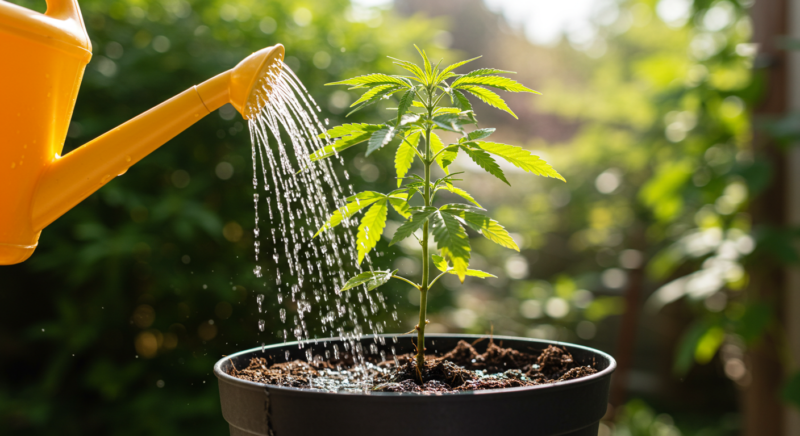
Soil Temperature Fluctuations: Containers are more susceptible to temperature changes than the ground. In sunny weather, soil in containers can heat up quickly, which might stress plants and lead to issues like root damage. Conversely, during cold nights, the soil in pots can lose heat rapidly, potentially harming the roots. To manage these fluctuations, growers might need to implement strategies such as using insulative materials around the containers or placing them in locations that moderate temperature extremes.
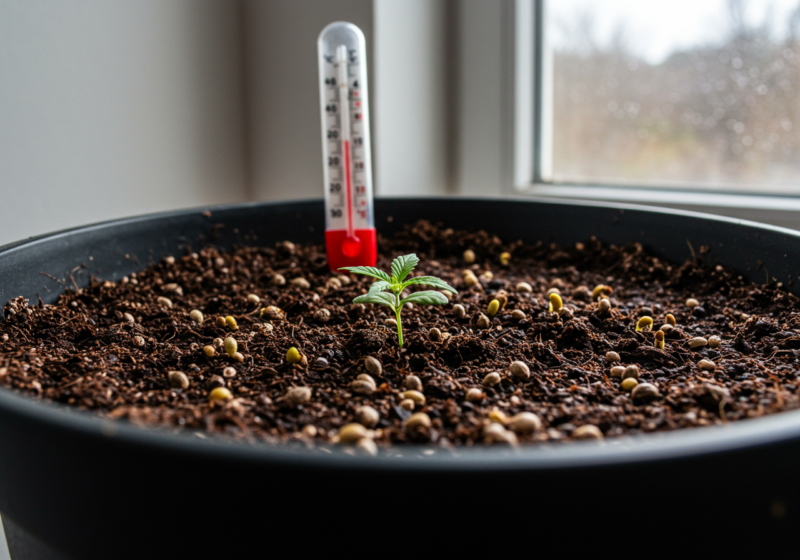
Selecting the Right Pots for Cannabis Cultivation

Choosing the right containers for growing cannabis is crucial for the health and productivity of your plants. The type of pot you select can seriously impact root health, moisture management, temperature control, and overall plant development. Each type of pot—fabric, plastic, smart, and terracotta—brings different benefits and considerations that can substantially affect the growing process.
Fabric Pots
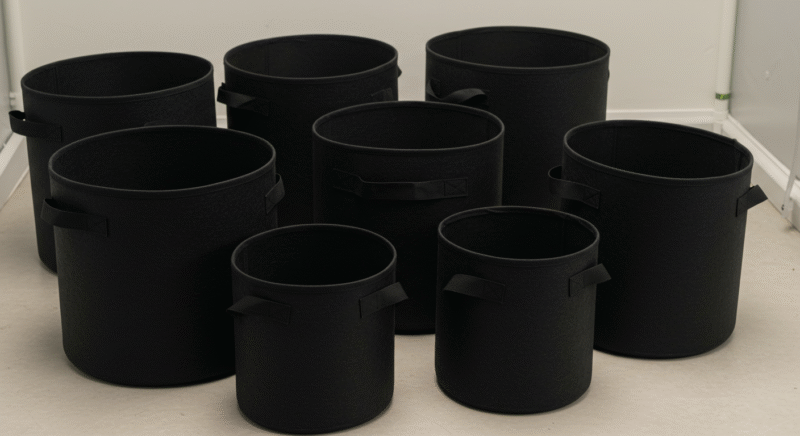
Fabric pots are made from breathable, often recycled materials, making them an eco-friendly choice for cannabis growers. Their main advantage lies in their ability to improve air circulation around the root zone. This increased airflow prevents root circling—a common issue in non-breathable pots where roots grow in circles and eventually strangle themselves. Instead, the roots in fabric pots grow outward until reaching the air at the edges of the pot, where they are naturally “air-pruned.” This pruning encourages the growth of new feeder roots, enhancing the plant’s ability to absorb nutrients and water.
Benefits: The enhanced airflow provided by fabric pots helps keep the root system cool and improves drainage, reducing risks of overwatering and root diseases like root rot. These pots also promote a more robust root system, leading to healthier plants capable of supporting more substantial top growth.
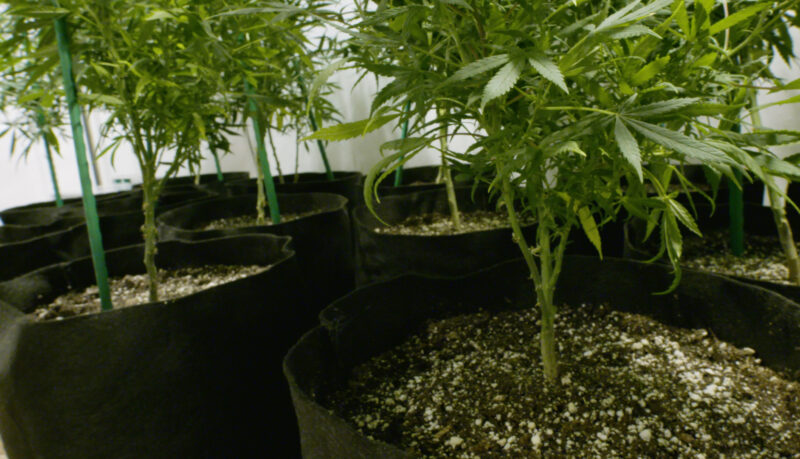
Considerations: Fabric pots dry out more quickly than other types of containers, requiring more frequent watering. This can be a drawback in hot climates or during peak summer months where daily watering might be necessary. Additionally, fabric pots may not be as durable as other options and can degrade after a few seasons of use, especially if exposed to harsh outdoor conditions.
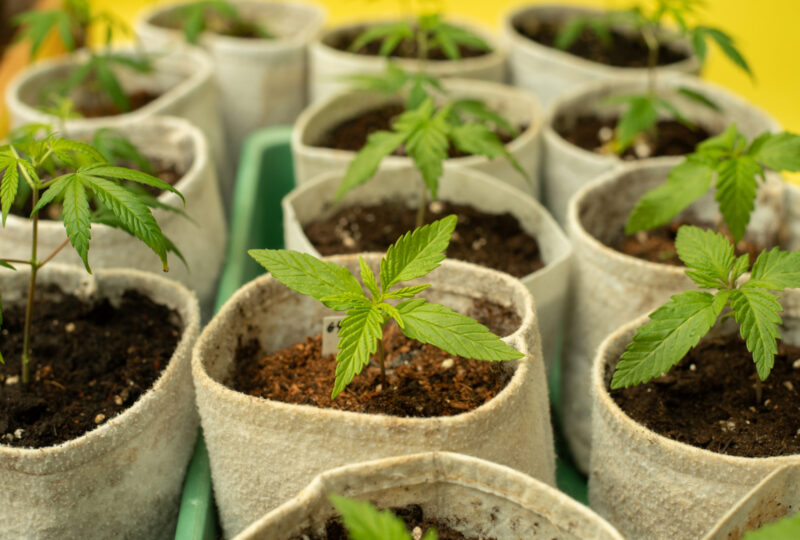
Recommendation: Fabric pots are ideal for growers who prioritize root health and are able to commit to the increased watering demands. They are particularly recommended for use in controlled environments where temperature and humidity can be managed effectively.
Plastic Pots

Plastic pots are widely used in cannabis cultivation due to their affordability, lightweight nature, and versatility in sizes and colors. They are ideal for growers who need to frequently adjust their setup or for those operating on a tight budget.
Benefits: These pots retain moisture longer, which can be beneficial during hot weather or in windy areas where dry conditions prevail. The moisture retention can reduce watering frequency, which is helpful for growers with large operations or limited time.
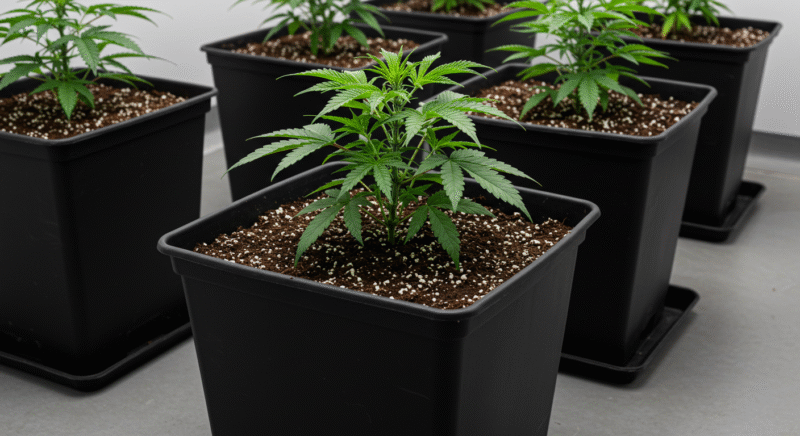
Considerations: The primary drawback of plastic pots is their poor aeration, which can lead to waterlogging and associated root issues if not carefully managed. Also, plastic can heat up quickly when exposed to direct sunlight, which might stress the roots on hot days. To mitigate this, growers can choose lighter-colored pots or place them in partially shaded areas.
Recommendation: Plastic pots are recommended for growers looking for a cost-effective, versatile solution, particularly those just starting out or experimenting with different plant placements.
Smart Pots
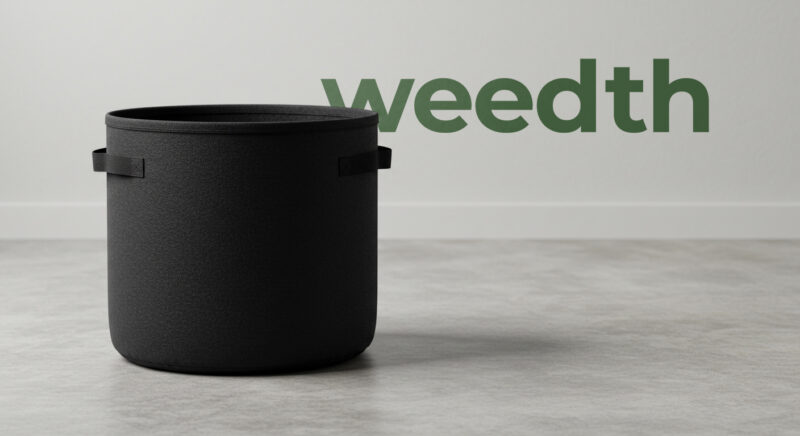
Smart pots are a specialized type of fabric pot designed to enhance the benefits of air pruning more effectively. They are typically made from a thicker, more durable fabric that not only prevents roots from circling but also keeps the growing medium temperature stable.
Benefits: Smart pots combine the advantages of traditional fabric pots with increased durability and stability. They promote excellent root health, leading to vigorous plant growth. These pots are particularly useful for growers looking for a long-term, reusable potting solution that maintains the benefits of air pruning and good drainage.
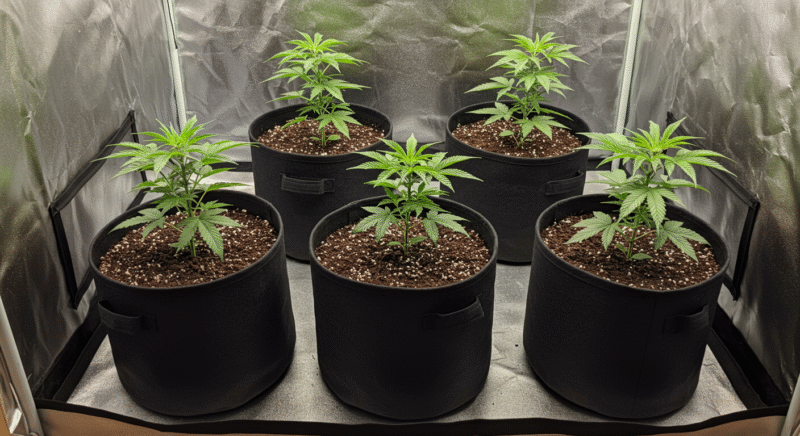
Considerations: Like regular fabric pots, smart pots require more frequent watering due to their porous nature. They may also be more expensive than standard fabric or plastic pots, representing a higher initial investment.
Recommendation: Smart pots are best suited for serious cultivators who want to maximize the health and productivity of their plants while benefiting from the durability and stability of these containers.
Terracotta Pots
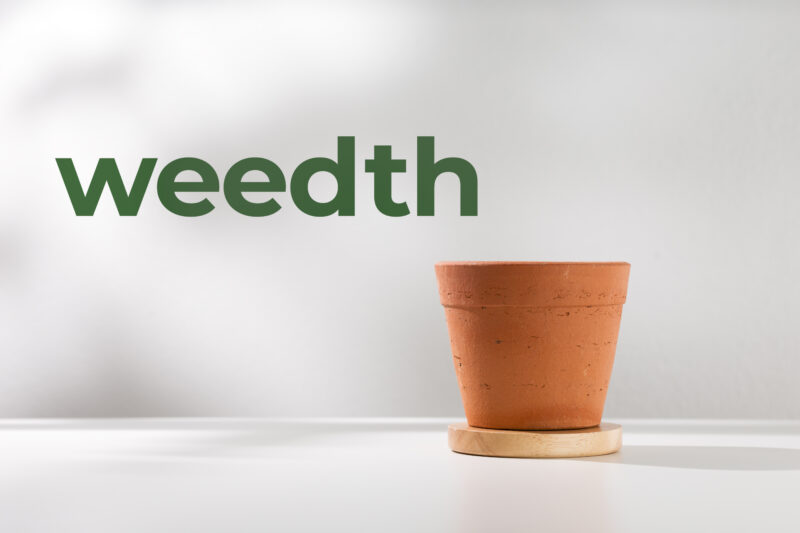
Terracotta pots are classic and visually appealing, made from naturally occurring clay. These pots are particularly valued for their aesthetic and their functional benefits in plant cultivation.
Benefits: Terracotta’s porous nature allows for natural air flow and water drainage, similar to fabric pots but with greater structural stability and thermal mass. This can help moderate soil temperature fluctuations and provide a healthy growing environment for cannabis roots.
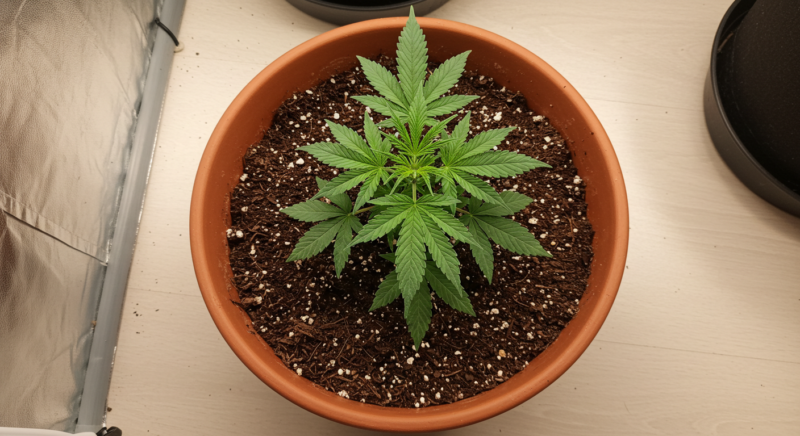
Considerations: The weight of terracotta pots makes them less ideal for growers who require mobility in their garden setups. They are also fragile and can crack or break if mishandled. Additionally, in areas with high mineral content water, terracotta can accumulate salt deposits that may need to be cleaned periodically.
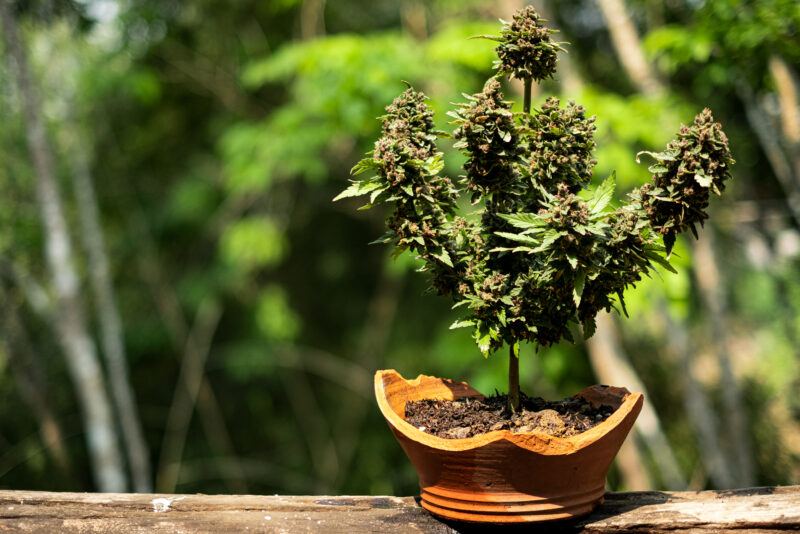
Recommendation: Actually, not good for growing but terracotta pots are recommended for growers who value aesthetics and have a permanent or semi-permanent setup where pots do not need to be moved frequently. They are particularly suited for growers in moderate climates where temperature fluctuations are minimal.
Ceramic Pots
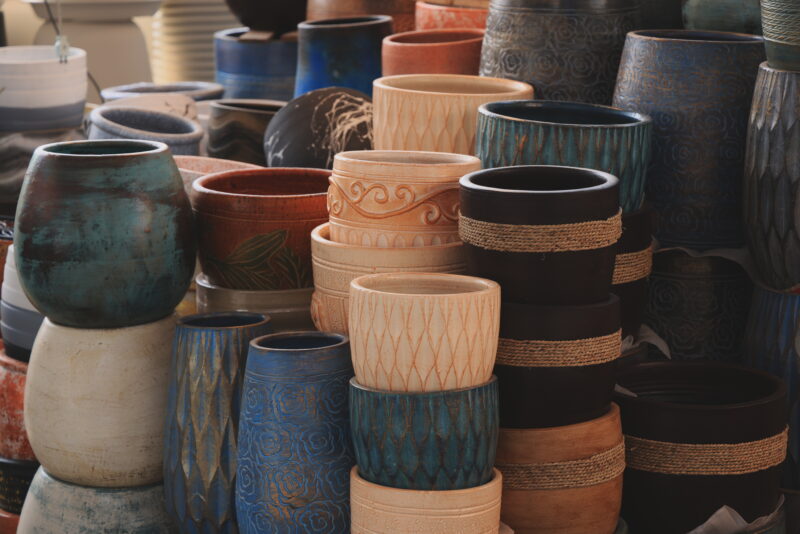
Ceramic pots like terracotta, are made from clay but are often coated with a glaze that seals the pores, reducing their permeability and increasing moisture retention. These pots are highly decorative and come in a variety of colors and finishes, making them a popular choice for growers who prioritize aesthetics alongside functionality.
Benefits: Ceramic pots provide excellent protection against temperature fluctuations, thanks to their thick walls. The glaze finish not only enhances the pot’s appearance but also helps retain soil moisture, reducing the frequency of watering needed.
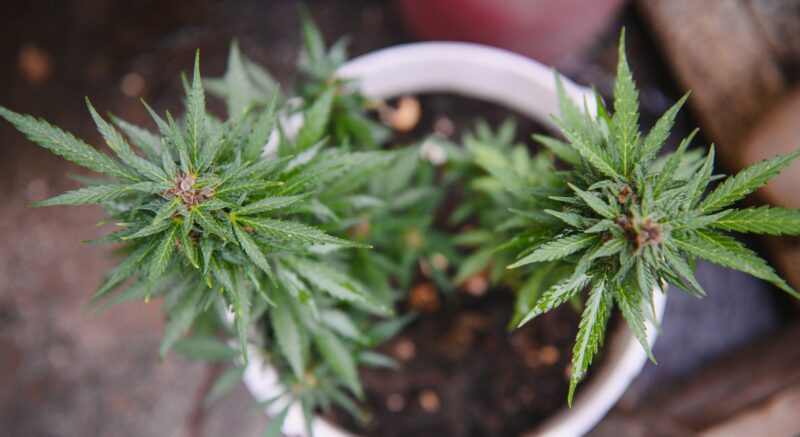
Considerations: Ceramic pots are generally heavier and more fragile than other types of containers. They are more expensive and do not provide the same level of air circulation to the roots as fabric, smart or plastic pots.
Size Considerations for Pots
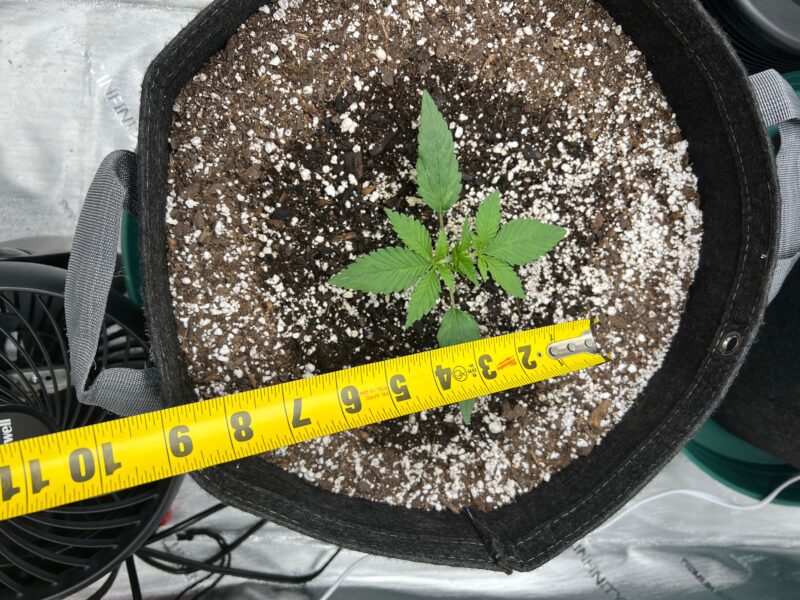
Size of the pot can significantly affect the root system’s health and the overall growth and productivity of the plant. Understanding how to match pot size to the plant’s size and growth stage is important to ensuring your cannabis plant.
Matching Pot Size to Plant Size or Growth Stage
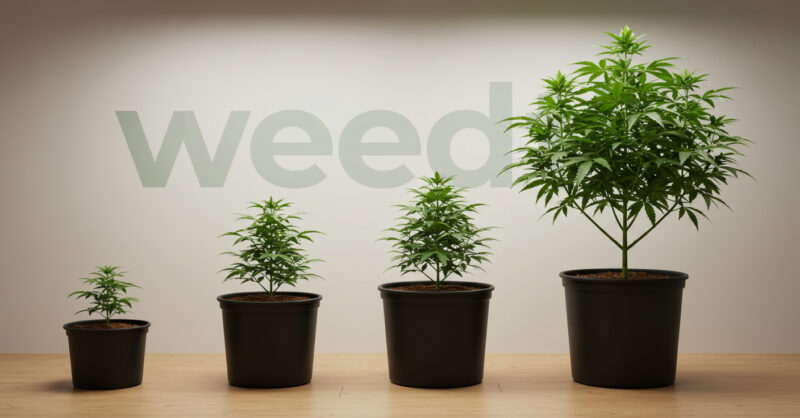
The size of the pot you choose should correlate with the size of your cannabis plant at each stage of its growth. A pot that is too small can restrict root growth, leading to “root-bound” conditions where the roots circle and choke each other, leading to stunted growth and a reduction in plant health. Conversely, a pot that is too large for a young plant can lead to waterlogging and nutrient leaching, as the soil’s volume may retain more water than the small plant can use.
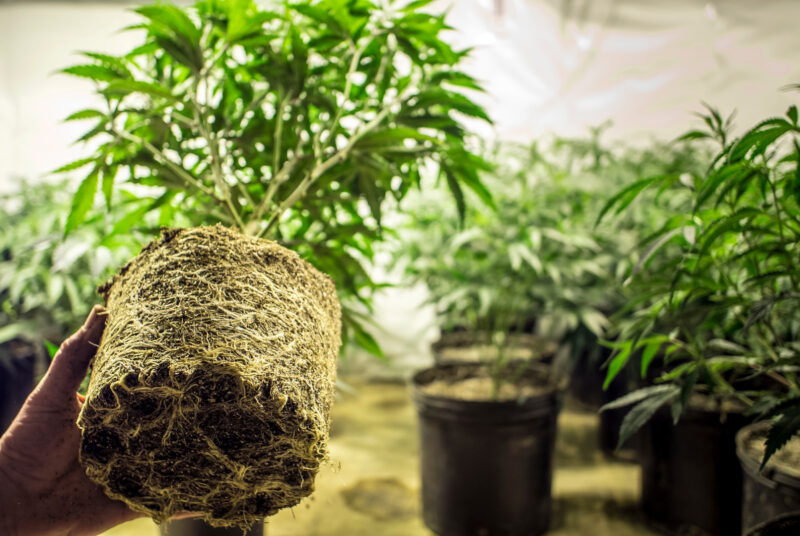
Seedlings and Clones: Young cannabis plants and clones are best kept in smaller containers such as 1 to 2 gallon pots. These smaller containers allow for adequate moisture retention and warmth required for developing young roots.
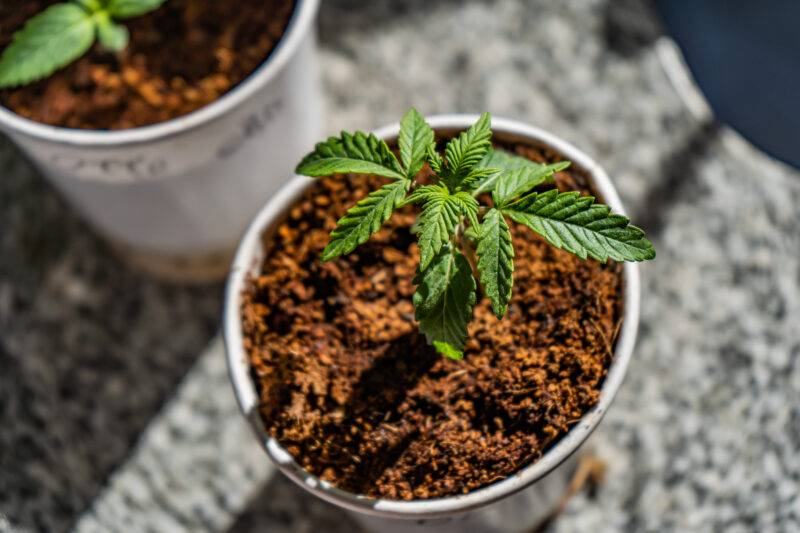
Vegetative Stage: As the plant grows, it will need more space to expand root system. Once a plant outgrows its starter pot, it should be transplanted to a larger pot. For the vegetative stage, 3 to 6 gallon pots are commonly used. These sizes allow the plant to establish a robust root system which is crucial for supporting healthy foliage and stem growth.
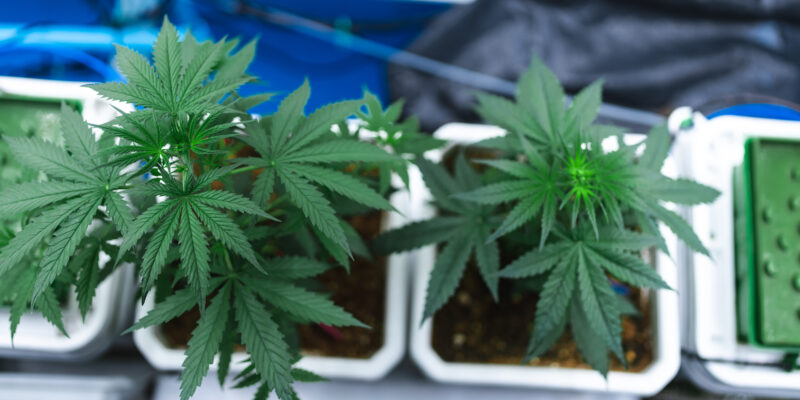
Flowering Stage: Firstly, avoid changing pots during the flowering stage but you can change pots one week before transitioning to the flowering stage. Space for root expansion becomes even more critical as the plant’s nutrient and water needs increase to support the development of large buds. Most growers opt for even larger pots, ranging from 7 to 10 gallons or more, depending on the expected size of the mature plant and the length of the flowering period. These larger pots accommodate the increased root mass and help prevent nutritional deficiencies during the bloom phase.

Recommended Sizes for Different Stages of Growth:
- Seedlings/Clones: 1-2 gallon pots
- Early Vegetative Stage: 3-5 gallon pots
- Late Vegetative Stage: 5-7 gallon pots
- Flowering Stage: 10+ gallon pots
Timing of Transplanting
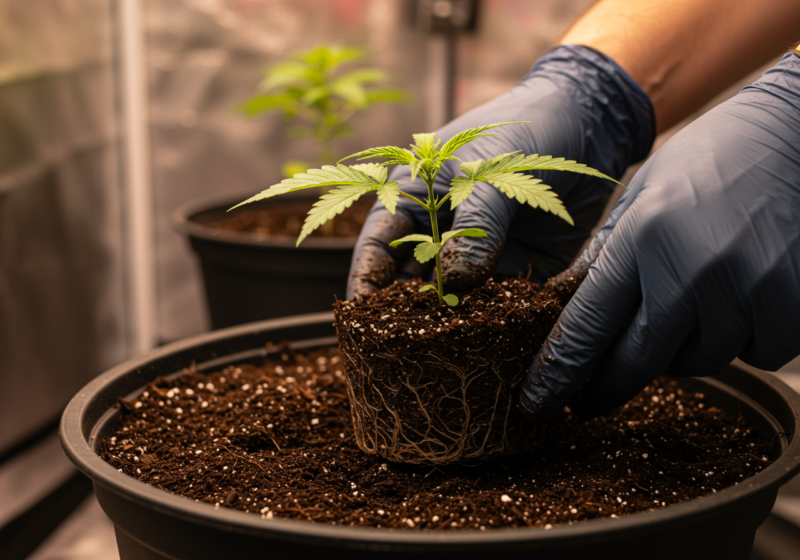
It’s crucial to avoid transplanting cannabis during the flowering stage. Moving plants to a new pot at this stage can cause significant stress, potentially affecting their overall health and productivity. The flowering phase is a critical time for the plant’s energy to be focused on bud development, not recovering from transplant shock. Planning your pot sizes and transplant schedule ahead of time can help ensure that plants are in their final container before the onset of flowering, minimizing stress and supporting optimal development.
Drainage Requirements for Pots
Adequate drainage ensures that water flows through the soil, providing moisture to the roots while preventing the detrimental effects of waterlogging. This balance is crucial for maintaining healthy root growth and overall plant vigor.
Ensuring Adequate Drainage Holes
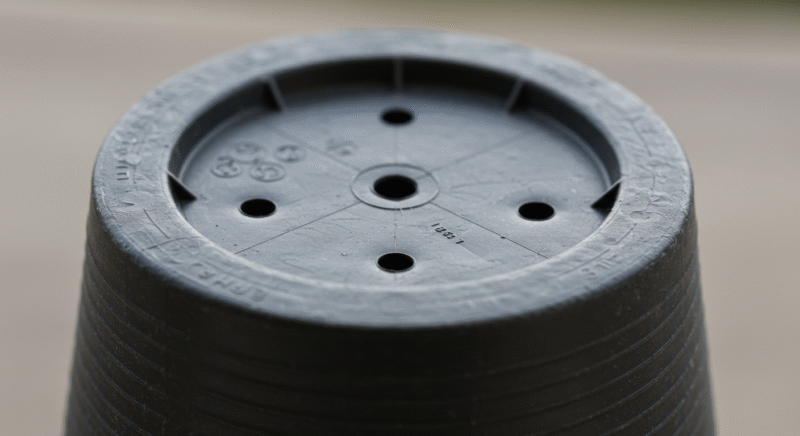
The first step in ensuring effective drainage in container-grown cannabis is the presence of adequate drainage holes at the bottom of the pot. These holes allow excess water to escape, which prevents the soil from becoming overly saturated and reduces the risk of root diseases such as root rot. When selecting pots for cannabis cultivation, always choose containers that already have drainage holes, or be prepared to drill them yourself if necessary.
For larger pots, multiple drainage holes spread across the bottom surface can enhance drainage efficiency, ensuring water does not pool in any part of the pot. The size of the holes should be large enough to allow water to pass freely but not so large that the soil washes out. Holes that are about 1/4 to 1/2 inch in diameter are adequate for most pot sizes.
Using Saucers Under Pots
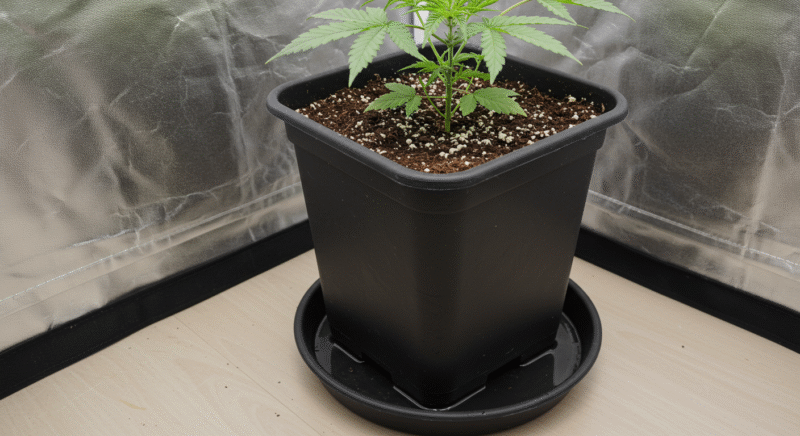
While drainage holes help remove excess water, using saucers under pots can help manage any runoff, keeping growing areas clean and reducing waste of water and nutrients. Saucers catch the water that drains out, which can be beneficial in preventing mess and water damage to floors or surfaces, especially for indoor growers. However, it’s crucial not to let the pots sit in the collected water as this can lead to the same issues as having no drainage at all.
For healthy plant growth, empty the saucers regularly, or even better, use them as a gauge to monitor how much water your plants are using. If saucers remain consistently full, you may be overwatering. Adjust your watering practices based on how quickly the water accumulates in the saucer.
Importance of Avoiding Waterlogged Soil
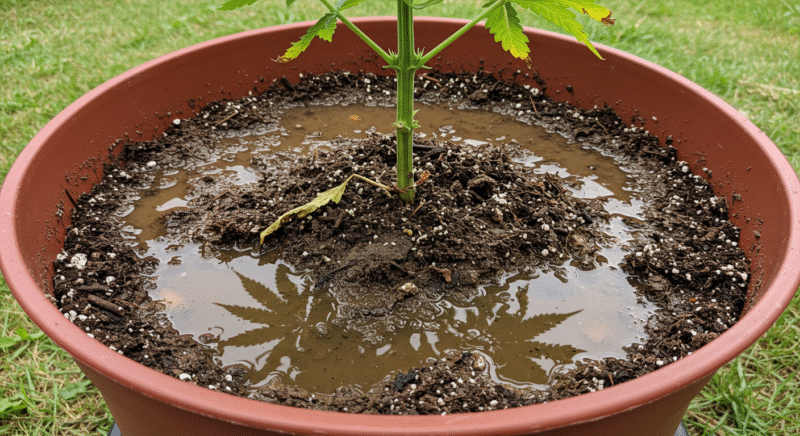
The importance of avoiding waterlogged soil cannot be overstated. Waterlogged or overly saturated soil conditions deprive the roots of oxygen, leading to weakened and dying roots. This anaerobic soil environment can also promote the growth of harmful fungi and bacteria that cause root diseases. Cannabis plants in waterlogged soil will often show signs of distress, such as yellowing leaves, wilting, and stunted growth, which can severely impact the overall yield and health of the plant.
Consider using a well-draining potting mix to ensure that the soil remains well-aerated and not waterlogged. A mixture that includes components like perlite, vermiculite, or coco coir can improve soil structure, enhancing its drainage capabilities while still retaining adequate moisture to meet the plants’ needs.
Preparing Pots for Planting Cannabis
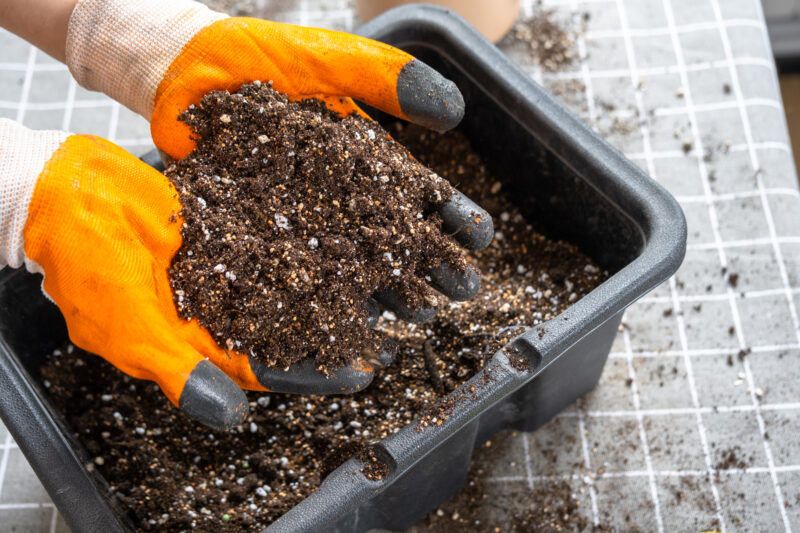
Successfully setting up pots involves selecting an appropriate soil mix, enhancing the soil with amendments, and ensuring the pots have proper drainage and aeration.
Choosing the Right Soil Mix for Pots
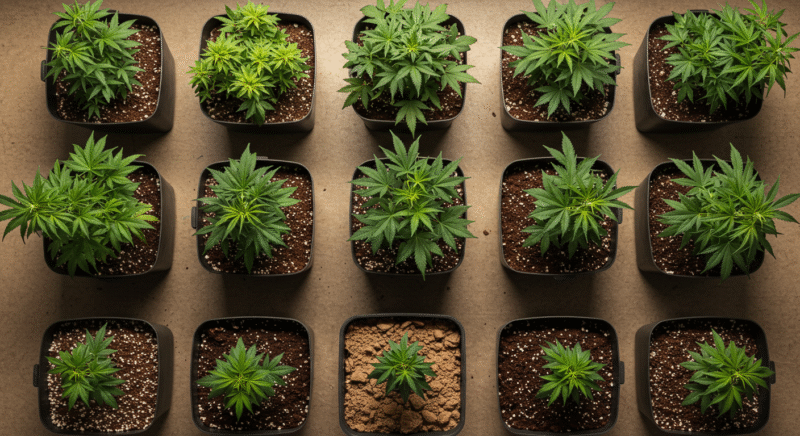
For cannabis grown in containers, a well-draining yet moisture-retentive soil mix is optimal. A suitable potting mix often includes peat moss or coco coir to help with moisture retention, perlite or vermiculite to ensure aeration, and organic compost to provide nutrients. This blend keeps the soil light and airy, allowing roots to expand freely and access necessary air.
It’s best to select a soil mix designed for container gardening, as these are specifically formulated to prevent compaction and support drainage. Garden soil should be avoided in pots since it can be too heavy and may carry pathogens or weeds.
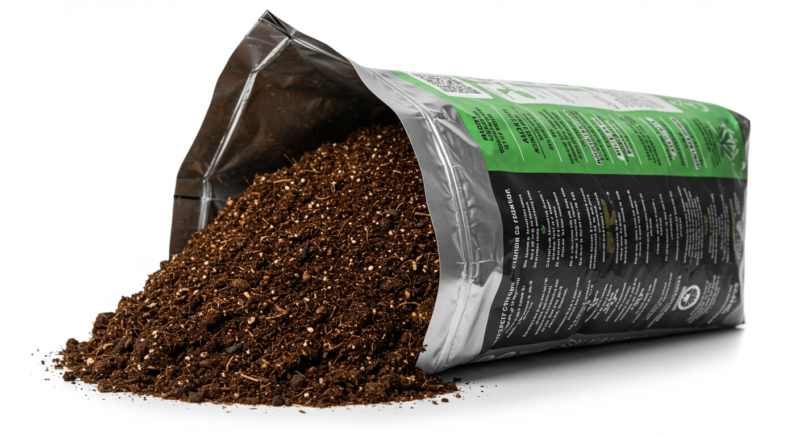
For the seedling stage, it’s crucial to use a soil mix that is clear and free of any added nutrients. Seedlings are very sensitive and can be easily damaged by nutrient-rich soils. Using a sterile, nutrient-free mix helps ensure that the young plants can develop strong root systems without the risk of nutrient burn or exposure to pathogens.
Adding Amendments to Enhance Soil Quality

Enhancing commercial potting mixes with specific amendments can provide additional benefits tailored to the needs of cannabis. Organic nutrients such as worm castings, bat guano, bone meal, or blood meal can be added to enrich the soil. These amendments release nutrients slowly, which is ideal for the extended feeding needs of cannabis.
Incorporating mycorrhizal fungi can also be beneficial, as these fungi form a symbiotic relationship with cannabis roots, improving their ability to absorb water and nutrients.
Ensuring Proper Drainage and Aeration
Effective drainage and aeration are essential to prevent waterlogging and ensure healthy root development. As you know, each pot should have adequate drainage holes at the bottom. If the existing holes are insufficient, additional holes can be added to improve water flow.
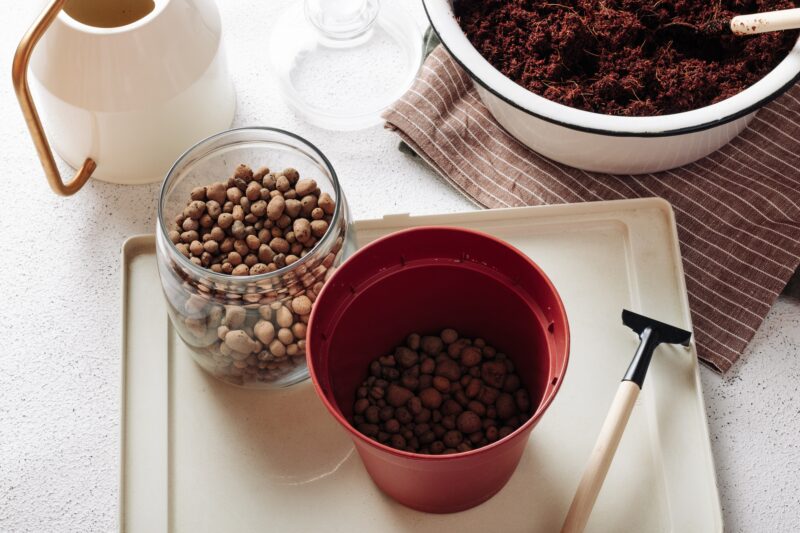
Placing a layer of coarse gravel or a non-biodegradable screen at the bottom of each pot can prevent soil from washing out while still allowing water to drain effectively. When filling pots with soil, avoid compacting it too tightly. Keeping the soil loosely packed helps maintain necessary air pockets, which support root health and facilitate proper moisture movement.
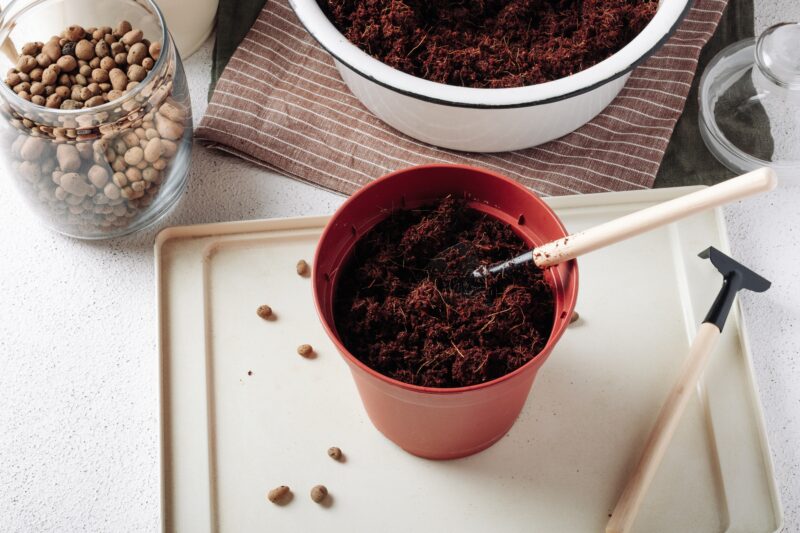
Additionally, monitoring how water moves through the soil over time is just as important as the initial setup. After watering, check how quickly excess water drains from the bottom of the pot. If water pools on the surface or takes too long to drain, it may indicate compaction or clogged drainage holes. In such cases, gently loosening the top layer of soil or adjusting the drainage setup can restore proper flow. Consistent observation allows you to catch potential issues early and maintain an optimal root environment throughout the entire grow cycle.
Avoid Using Outside Soil

It is important to avoid using soil from outside gardens, forests, or other natural areas in your pots. Such soil can harbor pests, diseases, and weed seeds that could jeopardize the plants health. Using commercially prepared and sterilized potting mixes ensures that your plants have a clean and safe environment to grow in, free from potential contaminants.



